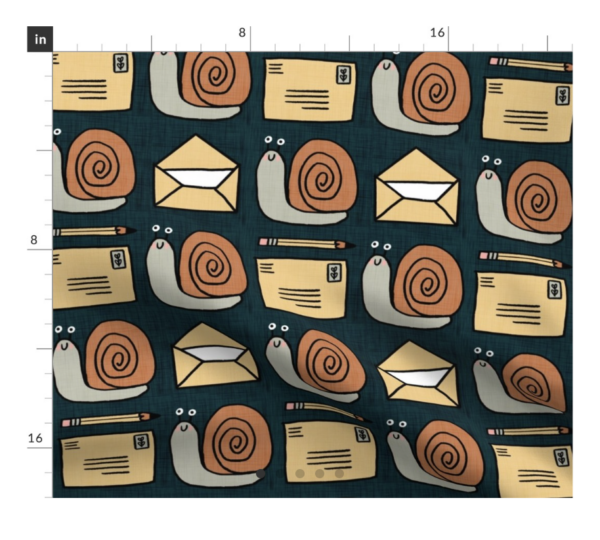Making Business Cards Fun
I ran out of business cards the other day and I wanted to do a little something fun before I reprinted them. I don’t know how much people use business cards these days, but I do! I always include one in Etsy orders and people often pick them up when I do in-person shows. The back of my cards has always been blank.
Back when I did more shows where I was selling wearable pieces, I used to put a sticker on the back with care instructions for a piece and I pinned the business card to each one to act as a tag. I always used a sticker because I had so many different fabrics, it made sense to just stick on the right sticker versus printing many different versions.
But I don’t tag everything like that anymore because I realize that the tags just get beat up and tangled between shows and handling and was making a lot of trash replacing them. So it was time to put something else on the back of the cards. I have one from a sequin shop that I have stuck on my file cabinet because it has a chart of sequin sizes with little circles so I can see the size at a glance. That’s a handy tool! I couldn’t think of a handy tool to use for my cards. A ruler seemed too generic and nothing else seemed to really relate to what I do. So instead I decided that the most “on brand” thing for me was to add a project!
I decided to make a charted pattern of Stanley, my labrador. If you follow me on social media, you know that he shows up in about half of my feed. He’s a studio mascot for sure. I played around and came up with a version of him that I liked and then charted it out in Illustrator. As I was working on it, I was thinking cross stitch, but the more I thought about it, the more I realized that there are tons of crafts you can do with a charted grid pattern: knitting, cross stitch, embroidery, tapestry crochet, perler beads, mosaics, diamond painting… So it’s a choose your own craft pattern! I’m hoping that people will maybe want to hang on to the card because it’s a fun thing rather than just putting it right into the recycling.
I stitched up a version to try it out and I love it.








 I worked for a huge part of my adult life at an art center. I stumbled in to it, answering a call for school residency teachers and ended up falling in love. There are lots of kinds of art centers; some are media specific, some include theater and music. There was an art center in the town where I grew up and I loved it there, but it was more of a museum style place. I’d never been to a place designed just for creative people to congregate and try to bring some more art into the world.
I worked for a huge part of my adult life at an art center. I stumbled in to it, answering a call for school residency teachers and ended up falling in love. There are lots of kinds of art centers; some are media specific, some include theater and music. There was an art center in the town where I grew up and I loved it there, but it was more of a museum style place. I’d never been to a place designed just for creative people to congregate and try to bring some more art into the world.  When I left my arts administrator job, I needed to step away from that art center I’d been a part of for all those years. Things had gotten a little toxic with some leadership changes and I needed a little distance. That was hard to do. But gradually I started “dating” some other orgs and found a few that seemed like a pretty good fit.
When I left my arts administrator job, I needed to step away from that art center I’d been a part of for all those years. Things had gotten a little toxic with some leadership changes and I needed a little distance. That was hard to do. But gradually I started “dating” some other orgs and found a few that seemed like a pretty good fit.



 This week has been a week of what I call a “sewing days”. I was working on a wholesale order for a collaboration I am doing with the Guthrie Shop and another for a shop in Seattle that sells my work. Today, I hemmed and pressed tea towels, I hand stitched the finishing on scarves, I serged tiny rolled hems on the edges of chiffon wraps.
This week has been a week of what I call a “sewing days”. I was working on a wholesale order for a collaboration I am doing with the Guthrie Shop and another for a shop in Seattle that sells my work. Today, I hemmed and pressed tea towels, I hand stitched the finishing on scarves, I serged tiny rolled hems on the edges of chiffon wraps. To be perfectly honest and practical, I am picky. I’m pretty sure I couldn’t afford to hire someone that paid as much attention to detail as I do. I don’t want my work to be sewn in factories overseas where workers are paid pennies for having the same skills I have. I don’t want half of that piece of art to be made with someone else’s hands.
To be perfectly honest and practical, I am picky. I’m pretty sure I couldn’t afford to hire someone that paid as much attention to detail as I do. I don’t want my work to be sewn in factories overseas where workers are paid pennies for having the same skills I have. I don’t want half of that piece of art to be made with someone else’s hands.
 The new Silver and Gold wallpapers are basically identical except for color. Each paper has a base or background color of either silver or gold that your design is printed on top of. The color of the paper shows through any white areas of the design and gives the overall colors of the design a tinted shimmer. You can see the unprinted selvedges of the paper here to get an idea what that base color looks like.
The new Silver and Gold wallpapers are basically identical except for color. Each paper has a base or background color of either silver or gold that your design is printed on top of. The color of the paper shows through any white areas of the design and gives the overall colors of the design a tinted shimmer. You can see the unprinted selvedges of the paper here to get an idea what that base color looks like. The back side of the paper is a plain white matte paper surface that feels a little like newsprint. Since it’s designed to have glue added to it, it soaked up the PVA I used for the book covers and glued to the cover boards as easy as anything.
The back side of the paper is a plain white matte paper surface that feels a little like newsprint. Since it’s designed to have glue added to it, it soaked up the PVA I used for the book covers and glued to the cover boards as easy as anything. Overall, I can’t say enough good things about this paper! The first thing I did when I finished making these book covers and I was waiting for the glue to dry was order 4 more swatches with different designs. I am planning to make a covered box next.
Overall, I can’t say enough good things about this paper! The first thing I did when I finished making these book covers and I was waiting for the glue to dry was order 4 more swatches with different designs. I am planning to make a covered box next.